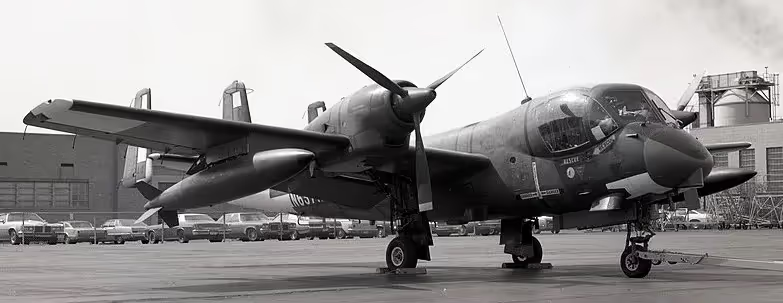Warplanes of the USA: Grumman OV-1 Mohawk

(U.S. Army Photo, Robert F. Dorr)
Grumman OV-1B Mohawk (Serial No. 59-2621), with the B model’s distinctive 18-foot side-looking radar (SLAR), mounted under the fuselage and offset to the right.
The Grumman OV-1 Mohawk is an American armed military observation and attack aircraft that was designed for battlefield surveillance and light strike capabilities. It has a twin turboprop configuration, and carries two crew members in side-by-side seating. The Mohawk was intended to operate from short, unimproved runways in support of United States Army maneuver forces.
The U.S. Army flew the OV-1 operationally in the Vietnam War, with sixty-five lost to accidents and ground fire, and one shot down by a North Vietnamese fighter. In early 1968, while flying an OV-1 over South Vietnam, U.S. Army Captain Ken Lee shot down a MiG-17 “Fresco” fighter jet with his XM14 .50 in. (12.7 mm) caliber gun pods as well as two M159 unguided rocket pods, becoming the only Army Aviator to ever down a MiG. Due to the Key West Agreement, the Army tried to keep the shootdown a secret for fear that it would allow the USAF to transfer Mohawks to its inventory. Lee's kill was finally formally recognized by the Army in 2007. (Wikipedia)
Starting in 1972, the Army National Guard (ARNG) began to receive the Mohawk, with the ARNG eventually operating thirteen OV-1Bs, twenty-four OV-1Cs, and sixteen OV-1Ds serving with three aviation units in Georgia and Oregon. The Oregon Army National Guard Unit operating the Mohawk was located at McNary Field in Oregon, initially as the 1042nd Military Intelligence Company (Aerial Surveillance), then reflagged as the 641st Military Intelligence Battalion (CEWI)(Aerial Exploitation).

(US Army Photo)
U.S. Army Grumman OV-1C Mohawk (Serial No. 60-3750) in flight.
In the summer of 1975, the Oregon ANG unit camp to CFB Wainwright, Alberta. The author was a Canadian Army Intelligence Officer assigned as a liaison to the unit and
As a young Canadian Forces Intelligence Officer, I worked with the Oregon ANG Mohawk crews who came up to take part in military exercises conducted at Camp Wainwright, Alberta. My boss, Captain Doug Whitley, the G2 for 1 CMBG, tasked me to keep them flying with photo Recce missions. The aircrafsurveillance of the Exercise battlefield during Waincon 75. The Mohawk had the ability to fly extremely low, then pop up to photograph our "enemy force" teams, and then speed on. The sound wouldn't alert the people being photographed until well after the aircraft had passed. The aircrews were mostly recent Vietnam Nam vets, and really knew their stuff. The Mohawks would return to our field and taxi in without shutting down. I would run out and task them with the next mission, while the film developed in on board Camera pods. A mobile truck mounted photo lab would be waiting for them on the runway. The camera pod and side-looking aerial radar (SLAR) data pack would be transferred to the lab truck and we read the large 12" wide rolls of negatives while they were still wet. A long way from the live feed aerial drones in use now, but at the time, we thought we were on the cutting edge of technology. Times change ;o) It was a privilege to have served with them.
U.S. Army OV-1s were retired from Europe in 1992, from South Korea in September 1996, and finally in the United States in 1996, superseded by newer systems, newer aircraft, and the evolution of reconnaissance satellites. The OV-1 was primarily replaced by the EO-5C, a militarized version of the de Havilland Canada Dash 7 turboprop airliner equipped with a SLAR system, until the U.S. Air Force's Northrop Grumman E-8 Joint STARS (Joint Surveillance Target Attack Radar System) aircraft became fully operational. (Wikipedia)

(U.S. Army Photo)
U.S. Army Grumman OV-1C Mohawk (Serial No. 61-6998).
.avif)
(USAF Photo)
The Grumman OV-1 Mohawk two-seat, twin-engine turboprop armed military observation and attack aircraft (U.S. Army).
%252C_USA_-_Army_AN1188459.avif)
(Mike Freer - Touchdown Aviation Photo)
Grumman OV-1D Mohawk SLAR variant, 73rd Combat Intelligence Company seen departing RIAT 85, 16 July 1985.

(Donald Huebler Photo)
Grumman OV-1D Mohawk, ice thickness surveillance aircraft, NASA.

(NASA Photo)
A Grumman OV-1B Mohawk (Serial No. 64-14244) used by the NASA Glenn Research Center for an icing test program, photographed on 1 March 1973. It flew for the NASA with the civil registration N637NA, and was later converted to an RV-1D. It was finally scrapped in March 1992.
.avif)
.avif)
.avif)
.avif)
.avif)
(Valder137 Photos)
Grumman OV-1D Mohawk at the 2010 TICO Warbird Airshow
Grumman OV-1D Mohawk preserved in the USA
Airworthy
_AN1395903.avif)
(Andre Wadman Photo)

(Sekinei Photo)

(Greg Goebel Photo)

(kitmasterbloke Photo)
_AN1663927.avif)
(Mike Freer - Touchdown Aviation Photo)
59-2604 – OV-1A flown by the Planes of Fame Air Museum in Chino, California.
59-2617 - OV-1A mounted on a concrete pylon. American Legion, John Colline Post 622, St. Francis, Minnesota.
.avif)
.avif)
(Perry Quan Photos)
62-5889 – Cavanaugh Flight Museum in Addison, Texas. Moved to North Texas Regional Airport, Denison, Texas.

(U.S. Army Photo)
62-5890 – Flown by the Carolinas Aviation Museum at airshows. C/N 49B. Sullenberger Carolinas Aviation Museum, Charlotte, North Carolina.

(Mike Freer - Touchdown-aviation Photo)
64-14262 – American Wings Air Museum, Blaine, Minnesota.

(Wing Attack Plan R Photo)
67-18899 – Tulsa Technology Centre, Tulsa, Oklahoma.

(Henry Tenby Photo)
67-18923 – N224TT. Operated by Mohawk Technologies and based at Palm Beach County Park Airport in Lantana, Florida.

(Hugh Dodson Photo)
67-18924 – N225TT. Tempest LLCc, Reno, Nevada.

(Mark Pasqualino Photo)
68-15936 – N134AW. American Wings Air Museum, Blaine, Minnesota.

(Chuck Gardner Photo)
68-15946 – N946AH. Operated by Mohawk Technologies and based at Palm Beach County Park Airport in Lantana, Florida. Beaver Falls Air Heritage Museum, Pennsylvania.

(Kenneth Smith Photo)
68-15947 – N947AH. Private owner, Merrimack, New Hampshire
69-17004 – Operated by Mohawk Technologies and based at Palm Beach County ParkAirport in Lantana, Florida.
Static display
57-6539 – YOV-1A on display at the United States Army Aviation Museum in Fort Novosel, Alabama.

(Reinhard Jost Photo)
59-2631 – N631HF. OV-1B on display at the Zephyrhills Museum of Military History in Zephyrhills, Florida.


(Mike Peel Photos)
59-2633 – OV-1B on display at Cradle of Aviation Museum.



(Ad Meskens Photos)
60-3740 – OV-1A on display at New Jersey Aviation Hall of Fame, Teterboro Airport, Teterboro, New Jersey.

(Articseahorse Photo)

(Author Photo)
60-3747 – OV-1C on display at the 1st Cavalry Division Museum in Fort Cavazos, Texas.

(Thompson Photo)
61-2700 – OV-1C on display at the Aviation History & Technology Center in Marietta, Georgia.
.avif)
(Georgia National Guard Photo)
Grumman OV-1B Mohawk (Serial No. 59-2431) taxis at Dobbins Air Base, 17 August 2011. Georgia Army National Guard Aviation Museum.

(aeroprints Photo)
.avif)
(Eric Salard Photo)

(kitmasterbloke Photo)

(Author Photo)
61-2724 – The Pima Air & Space Museum adjacent to Davis–Monthan Air ForceBase in Tucson, Arizona lists an OV-1C Mohawk as a static display.

(Daniel L. Berek Photo)
62-5856 – N6744. The Wings of Eagles Discovery Center owns an OV-1C on static display among its collection. New York
.avif)
(ZLEA Photo)
.avif)
(Alan Wilson Photo)
62-5860 – OV-1B on display at the United States Army Aviation Museum at Fort Novosel (previously Fort Rucker), Alabama.

(Hickory Aviation Museum Photo)
62-5874 – Hickory Aviation Museum, Hickory, North Carolina.

(Timothy Aanerud Photo)
62-5875 – Headquarters, 48th Infantry Brigade Combat Team, (Georgia Army National Guard) in Macon, Georgia displays a static OV-1D as part of an outdoor exhibit.

(Sclemmons Photo)

(kb7ywl Photo)
62-5880 – Texas Air Museum in Slaton, Texas has a modified OV-1D that was used by NASA that is on loan from the Museum of Naval Aviation.
.avif)
(ZLEA Photo)
62-5906 – Cockpit only on display at the Valiant Air Command Warbird Museum.
63-13128 – Military Aviation Preservation Society (MAPS) Air Museum (underrestoration for museum display). Merrimack, New Hampshire.
64-14247 – The United States Army's Tobyhanna Army Depot in Tobyhanna, Pennsylvania, has an OV-1B on display outside the main gate access control point.

(Woodlot Photo)

.avif)
(Joe Wentzel Photo)
64-14252 – The Mississippi Armed Forces Museum at Camp Shelby has an OV-1 onstatic display.

(John Bennett Photo)

(Nigel Hitchman Photo)
67-15959 – N226TT. Mohawk Technologies Llc, Lantana, Florida.

(Greg Goebel Photo)

(Shannon Lucas Photo)

(Clemens Vasters Photo)

(Parodygm Photo)
67-18902 – The Evergreen Aviation & Space Museum in McMinnville, Oregon displays a static OV-1D.

(Adrian Brooks Photo)
67-18922 – Hunter Army Airfield in Savannah, Georgia displays a static OV-1D aspart of an outdoor exhibit.


(Steve Divan Photos)
67-18926 – Salem Oregon, mounted on a pylon.


(Skytamer.com, AFIA Photos)
67-18930 – Fort Huachuca, Arizona maintains a static display of an OV-1 Mohawk.


(Matthew Vader Photos)
68-15939 – Vic's Antiques and Uniques, in Edinburgh, Indiana.

(J.S. (Steve) Bond Photo)
68-15958 - Rockaway, New Jersey.

(Ebyabe Photo)

(Hector Vazquez Photo)
69-16998 – The Valiant Air Command Warbird Museum at Space Coast Regional Airport in Titusville, Florida has a static OV-1 on display.
69-17007 – Part of Fort Cavazos, this Mohawk is on a pedestal in front of the 15th MI Bn on Robert Gray AAF on Mohawk Road.
69-17010? – The United States Army Aviation Museum at Fort Novosel, Alabama displays a static OV-1D as part of the outdoor exhibit at the intersection of Red Cloud Avenue and Ruf Avenue.

(John Bennett Photo)
69-17021 – The Fort Worth Aviation Museum at Fort Worth, Texas displays a static OV-1D as part of the outdoor exhibit.
Grumman OV-1 Mohawks preserved overseas
69-17022 - United States Army Garrison Humphreys in South Korea.

(GNC1808 Photo)
68-15932 – OV-1D, C/N 136C, Argentine Army Aviation AE-021 – displayed at the Argentine Army Museum, Museo Histórico del Ejército, Buenos Aires, Argentina.Grumman OV-1 Mohawk





